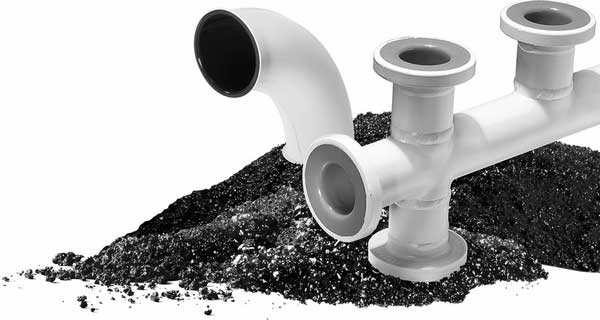Cement Mortar Lining
Cemented mortars are worldwide the most commonly used corrosion protective linings for steel pipes transporting potable water and wastewater.
In the water industry, a service life of 50 to 100 years, for a cement mortar lined pipeline is often required. This can be achieved by choosing cement mortar lining as the pipeline's corrosion protection system.

It is an option that offers complete quality while meeting manufacturing and industry standards in today's market. Different mortar linings are available for this task, depending on the corrosion load.
Manufacturing Process
Cement, fire-dried quartz sand and drinking water are used as standard to produce the cement mortar. The mortar is spun onto the pipe wall with the aid of an air motor-driven centrifugal wheel and then smoothed and compacted on a rotating station at defined speeds.
The rotation speed of the pipes is dimensioned in such a way that a homogeneous structure is ensured with maximum compaction and as little accumulation of fines as possible on the inner surface of the pipe. Fittings, flanges, and special spool pieces of any size are coated with hand trowel, spray gun or a combination.
The liner is then treated under controlled temperature and humidity conditions, giving it the optimum mechanical strength. The spinning process has the advantage of producing a smooth internal surface layer composed of very fine particles.
Connecting cement-coated piping
One of the most important parts of a cement-coated piping system is the joint. The two types of joints commonly used are the butt weld joint and the sleeve joint. The sleeve joint is factory welded to one end of the pipe or fitting, while the butt-weld joint is made in the field. A suitable joining agent is applied to seal the joint between the pipes.
Butt joint
After welding the cement-coated pipe, a hand-applied mortar is used to finish the cement coating on the inner surface of the steel pipe at the site of the field weld. The sides of the cement lining are first sealed with a primer layer consisting of one part of a universal resin-based adhesive. After this primer layer has become tacky, the ready-to-use mortar is applied. The mortar applied by hand is finished with a trowel or spatula and brushed flat after which a curing agent is applied. Pressure testing of a pipe section with cement lining applied on site shall be deferred until minimum compressive strength is achieved.
Sleeve joint
For sleeve joints up to 24 inches, a one-piece sleeve joint is used. For pipes over 24 inches, a half sleeve joint is usually used. The internal welds of sleeve joints are flushed ground without undercutting the parent metal. The radial weld seam between the pipe and sleeve of an assembly should normally not exceed 3 mm. During the assembly of a welded sleeve, with pipe or fitting, the weld must be offset at least 90 degrees with respect to each adjacent longitudinal weld. When welding a sleeve, care must be taken to ensure that the liner is not damaged by the heat applied during welding.
Butterfly valve installation
When a wafer butterfly valve is installed in cement-mortar lined pipes, the valve disc must be clear of the cement lining. If necessary, the liner should be beveled on the flange side to provide clearance between the valve disc and liner.
Mechanical performance of cement mortar
The quality of adhesion to the ductile iron wall gives the lining two important qualities..
- a good resistance to vacuum
- good resistance to longitudinal bending and ovality
Longitudinal bending tests on small-diameter pipes have shown that the cement mortar lining resists limited pipe diameter deflection.
For large diameter pipes, which are more sensitive to ovality effects, ring bending tests have confirmed the good performance of the mortar liner under high top loads.
Protective mechanism
The cement mortar coating is an active coating. It is not only a barrier coating, but also provides chemical protection through the passivation phenomenon. When the pipe is filled, the mortar gradually absorbs water, which is enriched with alkaline substances; thus, the mortar is not corrosive when it approaches the metal wall.
Crack plugging
Cracking (shrinkage) and small cracks often occur during transportation, storage or laying, but it cures under the combined effect of two reactions..
- swelling (fast) of the mortar in water
- hydration (slow) of the cement joints

Cement-lined pipes and fittings must be handled carefully to prevent internal damage to the cement lining. They should be adequately supported during storage, transportation and handling to prevent bending that may cause damage to the cement lining.
Codes and standards
- AWWA C205 - Cement mortar protective lining and coating for steel water pipes 4 inches and larger - applied in place
- AWWA C602 - Cement mortar lining of water pipes in place
- ASME B31.3 - ASME code for pressure piping - piping for chemical plants and oil refineries
- ASTM A82 - Standard specification for steel wire, plain, for concrete reinforcement
- ASTM A185 - Standard specification for welded wire steel, plain, for concrete reinforcement
Sleeve joint for Cement lined piping
History
Cement mortar has been used to internally protect pipes since the 1840s when it was introduced in France and the United States. It took some time to develop application techniques and it was not until the 1920s that the process of centrifugal spinning was introduced.
This process made it possible to quickly apply liners to the entire pipe surface by putting a mixture of sand, cement and water into the pipe and spinning it around at high speed. Spun Cement mortar lining, originally named for its inventor, was known for many years as the "Humes process". Humes Limited was a predecessor to the parent company of today's Australian Steel Mains Pty Ltd.
Related Post(s)

When it comes to adhesion between the lining and the base, glass wins hands down. Because the glass lining is made at extremely high temperatures, a mechanical...

